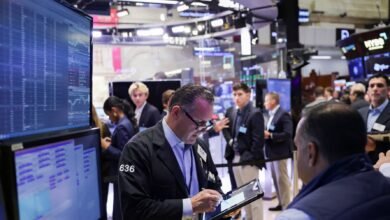Following the Fed’s interest rate cut, the Hang Seng Tech Index leads the global equity index rally.

The current valuation percentile of Hong Kong stocks is at a relatively high historical level. Looking ahead, the Hong Kong stock market is expected to trend upwards with fluctuations overall.
According to the China Galaxy Securities research report, the current valuation percentile of Hong Kong stocks is at a historically above-average level. Looking ahead, it is expected that the Hong Kong stock market will generally trend upwards with fluctuations. In terms of allocation, it is recommended to focus on the following sectors: (1) Sectors benefiting from favorable policies and industry trends, such as the AI industry chain, lithium batteries, and service consumption; (2) With the upcoming Mid-Autumn Festival and National Day holidays, activity in travel-related sectors is expected to increase; (3) Following the Federal Reserve’s interest rate cut and ongoing U.S.-China talks, market risk appetite has improved, and high-volatility technology stocks are likely to attract capital.
Key points from China Galaxy Securities:
Performance of Hong Kong stocks this week
(1) This week (September 15 to September 19), major global stock indices showed mixed results. Among them, Hong Kong’s three major indices collectively strengthened. The Hang Seng Index rose by 0.59% to 26,545.10 points, the Hang Seng Tech Index surged by 5.09%, and the Hang Seng China Enterprises Index climbed by 1.15%.
(2) At the sector level for Hong Kong stocks: Four sectors rose while seven sectors fell this week. Specifically, Industrials, Consumer Discretionary, and Information Technology led gains, rising by 6.08%, 3.57%, and 1.90% respectively. Meanwhile, Financials, Utilities, and Materials posted significant declines, falling by 3.60%, 2.59%, and 2.19%, respectively. From a sub-sector perspective, Electrical Equipment, Semiconductors, Automotive and Auto Parts, Consumer Discretionary Retail, and Coal saw notable increases, while Non-Bank Financials, Paper & Packaging, Construction Materials, Real Estate Investment Trusts, and Banks registered significant drops.
Liquidity in Hong Kong stocks this week
(1) The average daily trading volume of the Hong Kong Stock Exchange this week was HKD 347.12 billion, an increase of HKD 44.092 billion from last week. The average daily short-selling amount this week was HKD 32.485 billion, a decrease of HKD 1.913 billion compared to last week; the average proportion of short-selling amount to trading volume was 9.35%, down 2.03 percentage points from last week.
(2) This week, Southbound funds recorded a net inflow of HKD 36.851 billion, a decrease of HKD 23.971 billion from last week.
Valuation and Risk Appetite of Hong Kong Stocks
(1) As of September 19, the PE and PB of the Hang Seng Index were 12.04x and 1.23x, respectively, up 0.02% and 0.02% from last Friday, and at the 86th and 89th percentile levels since 2019, respectively. The PE and PB of the Hang Seng Tech Index were 23.86x and 3.49x, respectively, at the 34th and 74th percentile levels since 2019.
(2) On September 19, 2025, the yield on 10-year US Treasury bonds increased by 8 basis points (BP) to 4.14% from last Friday, while the risk premium of the Hang Seng Index was 4.17%, or -2.18 standard deviations below the three-year rolling average, at the 4th percentile since 2010. The yield on 10-year Chinese government bonds rose by 1.19 BP to 1.8789% from last Friday, resulting in a risk premium for the Hang Seng Index of 6.43%, or -2.0 standard deviations below the three-year rolling mean, at the 41st percentile since 2010.
(3) As of September 19, the Hang Seng Stock Connect AH Premium Index fell by 2.06 points to 117.11 compared to last Friday, representing the 9th percentile level since 2014.
Investment Outlook for the Hong Kong Stock Market
Internationally, on September 17 local time, the Federal Reserve announced its interest rate decision, with the FOMC deciding to cut the federal funds rate target range by 25 basis points to 4%-4.25%, marking the first rate cut of the year and the resumption of rate cuts after nine months. Fed Chair Jerome Powell stated that this 25-basis-point rate cut aims to address slowing economic growth and employment risks, and future decisions will be made meeting-by-meeting based on data. U.S. job growth has slowed, and downside risks to employment have increased. Expectations for Fed rate cuts have strengthened, boosting market risk appetite.
Domestically, China’s August economic data was released. In August, industrial output for enterprises above designated size grew by 5.2% year-over-year and 0.37% month-over-month, while the service sector production index increased by 5.6% year-over-year. Retail sales of consumer goods rose by 3.4% year-over-year and 0.17% month-over-month. From January to August, fixed-asset investment nationwide increased by 0.5% year-over-year, including a 5.1% increase in manufacturing investment and a 12.9% decline in real estate development investment.
Looking ahead, we recommend focusing on the following sectors in the Hong Kong stock market: (1) sectors benefiting from favorable policies and industry trends, such as AI supply chains, lithium batteries, and consumer services; (2) sectors related to travel and tourism expected to see increased activity as the Mid-Autumn Festival and National Day holidays approach; (3) following the Fed’s rate cut and ongoing U.S.-China talks, rising market risk appetite could favor high-volatility technology stocks.
Risk Warning: Risks include weaker-than-expected domestic policy implementation and effects, overseas rate cuts not meeting expectations, and unstable market sentiment.
Credit: Source link





